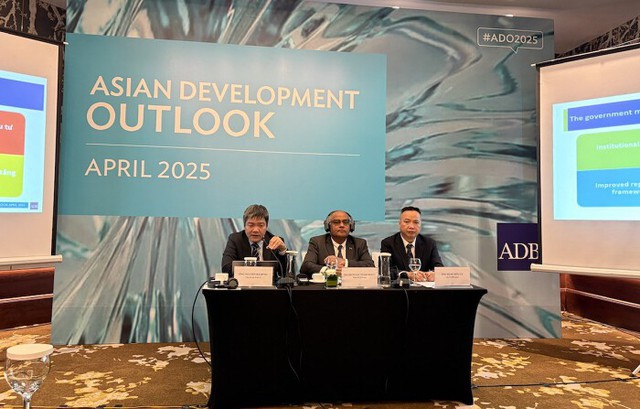Viet Nam’s economy gathers steam ahead of global challenges
VGP - Viet Nam’s economy is forecast to grow at 6.6 percent and 6.5 percent in 2025 and 2026, respectively, driven by strong trade, a recovery in export manufacturing, and robust foreign direct investment, according to the Asian Development Bank (ADB).

The press briefing of the Asian Development Outlook April 2025, Ha Noi, April 9, 2025
The international lender released the Asian Development Outlook April 2025 on April 9 in Ha Noi.
"Strong trade, a recovery in export manufacturing, and robust foreign direct investment fueled Viet Nam's economic growth in 2024", said ADB Country Director for Viet Nam Shantanu Chakraborty.
However, recent U.S. announcement of reciprocal tariffs, along with other continued global uncertainties, could pose significant challenges to the country's growth this year, he added.
While maintaining a positive outlook for Viet Nam this year and next, the Asian Development Outlook April 2025 highlighted risks to the forecasts, which were finalized before the announcement of U.S. tariff measures.
The evolving global economic environment, significantly affected by recent tariff-related announcements by the U.S. and geopolitical tensions, is posing significant challenges for economies dependent on export-driven manufacturing.
External uncertainties—such as tariff escalations, reciprocal measures, the prolonged war in Ukraine, and ongoing instability in the Middle East—could constrain near- to medium-term global economic growth. Moreover, a slowdown in the U.S. and the People Republic of China, Viet Nam's major trading partners, could further affect economic prospects.
The Government of Viet Nam has initiated an ambitious plan to boost growth, which can help mitigate the significant external risks, Mr. Chakraborty added.
Higher and sustainable economic growth is possible if ongoing, extensive institutional reforms are implemented swiftly and efficiently. Such reforms would stimulate domestic demand, increase governance efficiency in the near term, and consequently promote private sector development over the medium and long term.
Enhancing Viet Nam's participation in global supply chains is a critical policy challenge for the country's development. As global economic dynamics evolve, Viet Nam's advantages in value addition to global supply chains are also shifting. It is important to understand the limitations and challenges associated with broadening its participation in and increasing its added values to global supply chains, to improve the country's economic trajectory and long-term growth potential.
Earlier, various organizations have projected continued economic growth rates in Viet Nam. Specifically, the World Bank initially projected a 6.5 percent GDP growth rate for 2025 but later revised it upward to 6.8 percent in March 2025. ASEAN+3 Macroeconomic Research Office (AMRO) maintained a consistent forecast of 6.5 percent growth for 2025.
Despite the recent imposition of a 46 percent tariff on Vietnamese exports by the United States, the Vietnamese Government remains steadfast in its ambition to achieve a GDP growth target of at least 8 percent for 2025. Prime Minister Pham Minh Chinh emphasized the government's commitment to this goal, highlighting the necessity for flexible and adaptive strategies to navigate the challenges posed by the tariffs./.
